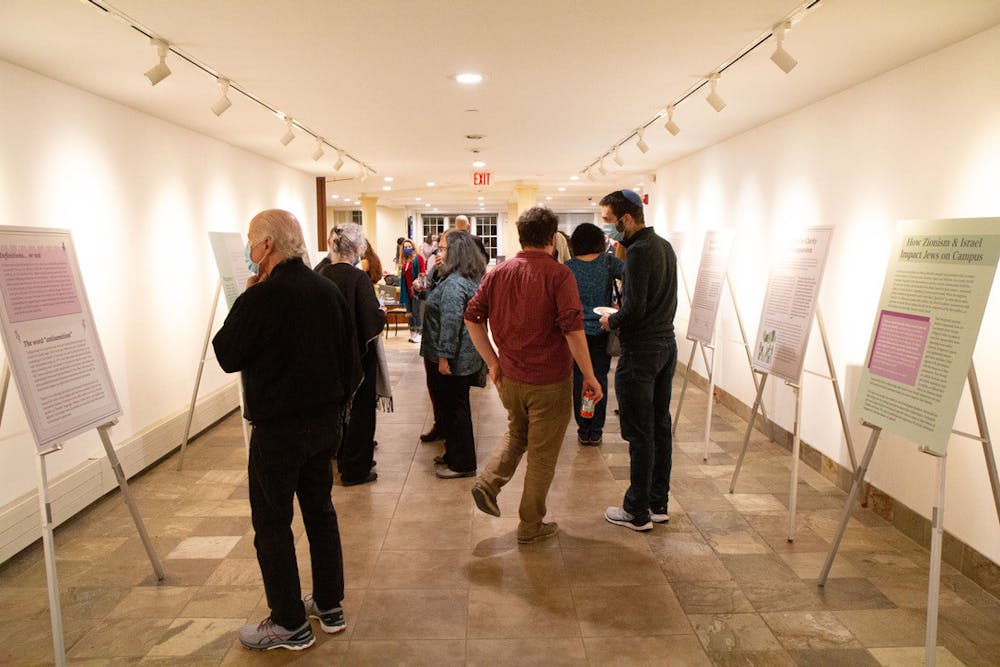Students, parents and scholars gathered Thursday night at Brown RISD Hillel to celebrate the launch of a guidebook created by Brown students which unpacks and confronts the issue of antisemitism.
The guidebook, titled “Love Thy Neighbor: A Guide for Tackling Antisemitism While Committing to Justice for All,” is the culmination of two years of learning and research by Narrow Bridge Fellows Maya Dayan ’21, Elana Nussbaum-Cohen ’23.5, Isaac Sonnenfeldt ’22.5 and Andrew Steinberg ’22. The resource was compiled into a comprehensive guidebook by Sonnenfeldt and Hannah Gelman ’22.
The Narrow Bridge Project was created by Rabbi Michelle Dardashti, associate University chaplain for the Jewish community, in an effort to bridge divides within the Jewish community and allow students to engage with topics of antisemitism, Jewish identity and Zionism in a bipartisan context.
At the project’s beginning, “antisemitism was growing on both the right and the left,” Dardashti said. She noted that many Jewish community members were divided on the definition of antisemitism and, as such, struggled to proactively work against it.
“It was clear to me that if we weren’t even able to agree on a definition of antisemitism — and who are our allies and who are our enemies — we were certainly in no shape to confront (antisemitism) together,” Dardashti said.
Dardashti created a learning cohort of students who discussed these topics in a seminar-style class. Some students who had completed the class, however, wanted to continue their research and learning. Their explorations took on new life as they created the guidebook so others could understand and confront antisemitism.
As part of the cohort, Sonnenfeldt worked with his co-fellows to share their learning with the greater community. “It’s a very treasured, safe space for me to talk to Jewish people about how we’re feeling and coming at it with such diverse perspectives,” Sonnenfeldt said. “We fought in that class, we had arguments, but I think what was so special is that we were also committed to being in this learning experience together and engaging (with) one another.”
Sonnenfeldt added that “this project is really a testament to how successful (community conversation) can actually be, even around a topic that is as contentious as Israel-Palestine.”
After attending a presentation by the NBP fellows, Gelman joined the project to present this knowledge in the form of a guidebook so it could be a more widely-accessible resource. “The work that they were doing was really answering my own questions, questions that I wished I could more clearly articulate answers” for, Gelman said. “I thought, ‘This is a resource that needs to exist.’”
The guidebook launch included a gallery walk which introduced the purpose of the guidebook: “to show readers the web of history and experiences that make up the hows, whys and whats of antisemitism,” the gallery read. Following Dardashit’s opening remarks, Steinberg, Nussbaum-Cohen, Sonnenfeldt and Gelman shared the process of creating the guidebook and what it meant to have conversations about antisemitism. Attendees could then walk through a hallway lined with enlarged prints of the guidebook’s pages.
“When it came to Brown, I learned that it was really hard for me to be in places that were supposed to be religious without (politics) being a part of it,” Gelman said in a speech to event attendees. “For someone who is involved in political activism or someone who is like, ‘Why do I feel uncomfortable in Hillel?’… this hopefully is an attempt to answer those questions in a way that is humble and honest, but also productive.”
Ashley Guo is an arts & culture writer and layout designer. She previously covered city and state politics as a Metro section editor. In her free time, Ashley enjoys listening to music, swimming, and reading!





